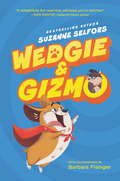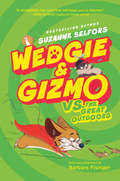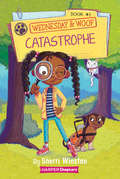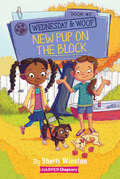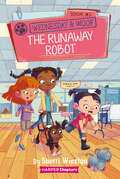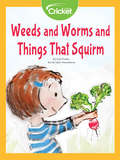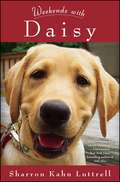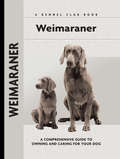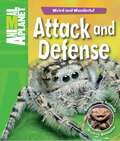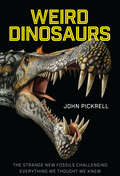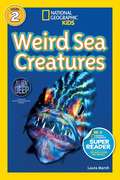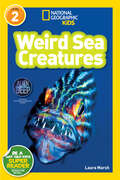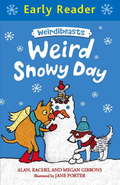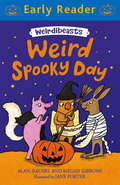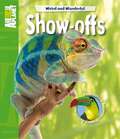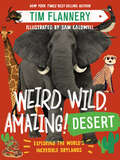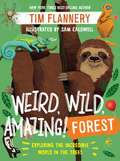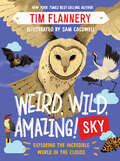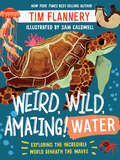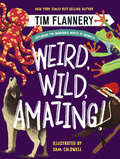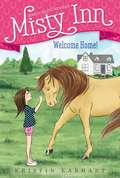- Table View
- List View
Wedding Dogs: A Celebration of Holy Muttrimony
by Sam Stall Katie Preston ToepferWedding Dogs captures man's best friend at 75 weddings--dogs as the best man, maid of honor, ring bearer, or another member of the wedding party! Decked out in little doggy tuxedos or sporting a wreath of roses around their necks, these pooches share in the wedding couple's big day. Each photograph is accompanied by a brief essay telling the dog's (and the couple's) story. A perfect wedding, bridal shower, or groom's gift, Wedding Dogs shares the joy of the moment when dogs join in the celebration of their owners' most special day.
Wedgie & Gizmo (Wedgie & Gizmo #1)
by Suzanne Selfors Barbara Fisinger<p>Fans of Stick Dog and My Big Fat Zombie Goldfish will love Suzanne Selfors’s hilarious new illustrated series about the growing pains of blended families and the secret rivalry of pets. <p>When a bouncy, barky dog and an evil genius guinea pig move into the same house, the laughs are nonstop! Wedgie is so excited, he can’t stop barking. He LOVES having new siblings and friends to protect. He LOVES guinea pigs like Gizmo! He also LOVES treats! <p>But Gizmo does not want to share his loyal human servant with a rump-sniffing beast! He does not want to live in a pink Barbie Playhouse. Or to be kissed and hugged by the girl human. Gizmo is an evil genius. He wants to take over the world and make all humans feel his wrath. But first he must destroy his archenemy, Wedgie, once and for all!</p>
Wedgie & Gizmo vs. the Great Outdoors (Wedgie & Gizmo #3)
by Suzanne Selfors Barbara Fisinger“A delightfully fun read that will leave you in stitches!”—Caldecott Medalist Dan SantatFans of Stick Dog and My Big Fat Zombie Goldfish will LOL when rival pets Wedgie and Gizmo brave their first family camping trip in book three of bestselling author Suzanne Selfors’s hilarious illustrated series. Wedgie and Gizmo’s humans are taking their first family vacation—to a campground by a lake! And their pets are too destructive to stay home alone. Wedgie the corgi is super-excited. He can’t wait to chase squirrels and poop in the woods!But Gizmo, the evil genius guinea pig, has no time for games. He must convince the forest critters to join his Evil Horde and help him take over the world—one tent at a time.Muh-hah-hah!
Wedgie & Gizmo vs. the Toof (Wedgie & Gizmo #2)
by Suzanne Selfors Barbara FisingerWedgie LOVES the new micro-pig next door. And she LOVES him! They both like to go for walks and roll in smelly things. They are going to be in the school pet parade together. They are best friends. But Gizmo knows the truth. The pig is Wedgie’s new sidekick. Super Wedgie and the Toof have teamed up to stop Gizmo from taking over the world. But they will not win! Gizmo is an evil genius. He is smarter than most comic book villains. And more powerful than even Darth Vader! He ordered a flying machine online and he will use it to set free all the guinea pigs at the pet parade. Then they will crush both dog and pig and make all humans feel their wrath. Muh-ha-ha!!
Wednesday and Woof #1: Catastrophe (HarperChapters)
by Sherri WinstonCan Wednesday and her service dog, Woof, sniff out Mrs. Winter’s missing cat before her big trip? This is the first book of a fun full-color early chapter book series about the best detectives in the Midwest!Detective Tip #1 Try not to jump to conclusions. Wednesday and her service dog, Woof, are the best detectives in the whole world—or at least their neighborhood. But can they find Mrs. Winters’s missing cat before her big trip? Or will the case of the cat-napped kitty be their first unsolved mystery? HarperChapters build confident readers one chapter at a time! With short, fast-paced books, art on every page, and milestone markers at the end of every chapter, they're the perfect next step for fans of I Can Read!
Wednesday and Woof #2: New Pup on the Block (HarperChapters)
by Sherri WinstonCould a friend really have taken Wednesday’s brother’s prized possession? Wednesday and her service dog, Woof, take the case in the second book of this full-color early chapter book series about the best detectives in the Midwest!Detective Tip #2 Don’t forget to use your eyes, ears, and even your nose. Wednesday’s brother’s drone went missing in their own backyard. And that can mean only one thing—the thief is one of their friends! Can the neighborhood’s newest service dog help Wednesday and Woof sniff out the bandit? Or will the case of the missing drone be a doggone disaster?HarperChapters build confident readers one chapter at a time! With short, fast-paced books, art on every page, and milestone markers at the end of every chapter, they're the perfect next step for fans of I Can Read!
Wednesday and Woof #3: The Runaway Robot (HarperChapters)
by Sherri WinstonIt’s a double mystery when a robot and a hamster go missing before the science fair in the third book of this full-color early chapter book series about the best detectives in the Midwest!Detective Tip #3: Use your imagination and stay calm!When a classmate’s DIY robot goes missing right before the school Science Fair, Detective Wednesday Nadir and her service dog, Woof are sure they can find it…until the class hamster also disappears! Now the pressure is on! Can Wednesday and Woof use the scientific method to solve two cases at once—or will the stress cause a mess?HarperChapters build confident readers one chapter at a time! With short, fast-paced books, art on every page, and milestone markers at the end of every chapter, they're the perfect next step for fans of I Can Read!
Wee Little Bunny (Wee Little)
by Lauren ThompsonSettle down with Little Bunny in this board book edition of his hop-along adventures.Little Bunny just can’t sit still. It’s not that he doesn’t want to hear the tortoise’s story or play with the fox. He just can’t seem to stay in one place long before he has to hop, hop, hop off and play. The only person who can get him to calm down is his mama, and when she does, he gets to tell her all about his busy day! This sturdy board book edition is perfect for even the youngest of readers!
Weeds and Worms and Things That Squirm
by Gail ParkerWhat kinds of plants grow in the garden? Carrots, radishes, and … a furry plant?
Weekends with Daisy
by Sharron Kahn LuttrellCurrently in development with CBS Films, this is the emotional and uplifting memoir of a woman who became a volunteer trainer for Daisy, a sweet yellow Lab puppy, and her unique relationship with the inmate who is Daisy's partner in the Prison PUP program.When Sharron Luttrell, a journalist still deeply mourning the loss of her family dog, found out about a weekend puppy raiser program for a service dog organization, she knew it was just she needed to help her move on. It seemed ideal; pick up a puppy on Friday, return it on Sunday night, get a new puppy each year. No strings attached. Well, it turns out that there were strings - and they tugged at her every Sunday evening when she had to return "her dog" to prison. This memoir chronicles Sharron's year co-parenting Daisy, a sweet lab puppy, with Keith, a convicted felon serving a decades-long sentence. As Sharron and Keith develop a rapport based on their brief weekend handovers (an exchange she describes as "divorced parents handing over the kids"), she begins to speculate about what the quiet, gentle Keith could have done to wind up in medium-security prison. When, through an accident of fate, Sharron finally discovers the crime Keith actually committed, she is shaken to her foundation. How can she continue to work with him, knowing what she does? But can she dismiss her personal experience with him, which has been nothing but kind? Ultimately, she looks to Daisy to pull her through--she must "think like a dog" and react in the present, not the past. Mindful of how much Daisy has taught her in a short time, Sharron can also see how much this special dog has helped Keith learn empathy, remorse, and to face the consequences of his actions. As the two of them work tirelessly to ensure that Daisy passes her final test and fulfills her destiny by becoming a service dog, Sharron tests the limits of her own strength, compassion, and capacity for love.
Weimaraner
by Lavonia HarperThe experts at Kennel Club Books present the world's largest series of breed-specific canine care books. Each critically acclaimed Comprehensive Owner's Guide covers everything from breed standards to behavior, from training to health and nutrition. With nearly 200 titles in print, this series is sure to please the fancier of even the rarest breed!
Weird And Wonderful: Astonishing Animals, Bizarre Behavior
by Prof. Phil Whitfield Animal Animal PlanetThe leading media brand for all things animal, this is an exciting and innovative book program that continues to deliver engaging, high-quality information about the animal kingdom. Launched in 1997, Animal Planet today has a unique global reach. It is broadcast in more than 96 million US households and 165 other countries, in 24 languages. Come face to face with the record breakers of the animal kingdom in this lavishly illustrated new series. Each title features more than 200 of the world's most extraordinary animals and their sometimes-bizarre behavior. Marvel at the amazing strategies animals deploy to track, catch and kill their prey; how they defend themselves from attack; how they rear their young, survive in extreme temperatures, and adapt to life in the ocean's depths.
Weird Dinosaurs: The Strange New Fossils Challenging Everything We Thought We Knew
by John PickrellFrom the outback of Australia to the Gobi Desert of Mongolia and the savanna of Madagascar, the award-winning science writer and dinosaur enthusiast John Pickrell embarks on a world tour of new finds, meeting the fossil hunters who work at the frontier of discovery. He reveals the dwarf dinosaurs unearthed by an eccentric Transylvanian baron; an aquatic, crocodile-snouted carnivore bigger than T. rex that once lurked in North African waterways; a Chinese dinosaur with wings like a bat; and a Patagonian sauropod so enormous it weighed more than two commercial jet airliners. Other surprising discoveries hail from Alaska, Siberia, Canada, Burma, and South Africa. Why did dinosaurs grow so huge? How did they spread across the world? Did they all have feathers? What do sauropods have in common with 1950s vacuum cleaners? The stuff of adventure movies and scientific revolutions, Weird Dinosaurs examines the latest breakthroughs and new technologies that are radically transforming our understanding of the distant past. Pickrell opens a vivid portal to a brand-new age of fossil discovery, in which fossil hunters are routinely redefining what we know and how we think about prehistory's most iconic and fascinating creatures.
Weird Dinosaurs: The Strange New Fossils Challenging Everything We Thought We Knew
by John Pickrell&“A tour de force…highlights the odd reptiles that roamed all corners of the earth millions of years ago.&”—Sydney Morning Herald From the outback of Australia to the Gobi Desert of Mongolia and the savanna of Madagascar, the award-winning science writer and dinosaur enthusiast John Pickrell embarks on a world tour of new finds, meeting the fossil hunters who work at the frontier of discovery. He reveals the dwarf dinosaurs unearthed by an eccentric Transylvanian baron; an aquatic, crocodile-snouted carnivore bigger than T. rex that once lurked in North African waterways; a Chinese dinosaur with wings like a bat; and a Patagonian sauropod so enormous it weighed more than two commercial jet airliners. Other surprising discoveries hail from Alaska, Siberia, Canada, Burma, and South Africa. Why did dinosaurs grow so huge? How did they spread across the world? Did they all have feathers? What do sauropods have in common with 1950s vacuum cleaners? The stuff of adventure movies and scientific revolutions, Weird Dinosaurs examines the latest breakthroughs and new technologies that are radically transforming our understanding of the distant past. &“This history of the discovery of some of the most outlandish creatures that ever lived, and the excitement of paleontological research, will be sure to both entertain and instruct.&”—Spencer Lucas, author of Dinosaurs: The Textbook, Sixth Edition &“Fascinating.... Readers learn of beautiful opalised dinosaur bones from Australia and a crested dinosaur found approximately 13,000 feet up Antarctica's Mt. Kirkpatrick, demonstrating that dinosaurs were widely distributed across the globe.&”—Publishers Weekly
Weird Sea Creatures (National Geographic Kids Readers #Level 2)
by U. S. National Geographic Society Staff Laura Marsh National Geographic Kids StaffMany strange sea creatures live in the ocean. Some are beautiful. Some are ugly. Some are cute, and some are scary. Weird sea creatures are strange for a reason.
Weird Sea Creatures (National Geographic Kids Readers)
by Laura MarshDid you know that the deep-sea anglerfish has a glowing fishing rod attached to its body, or that the barreleye fish has a see-through head? See these wacky creatures and more in this brilliantly illustrated book that explores the strangest creatures under the sea. This level two reader uses easy-to-grasp language that will keep children intrigued and learning on every page.This high-interest, educationally vetted series of beginning readers features the magnificent images of National Geographic, accompanied by texts written by experienced, skilled children's book authors. The inside back cover of the paperback edition is an interactive feature based upon the book. Level 1 books reinforce the content of the book with a kinesthetic learning activity. In Level 2 books readers complete a Cloze letter, or fun fill-in, with vocabulary words.Releases simultaneously in Reinforced Library Binding: 978-1-4263-1048-5 , $13.90/$15.95 Can
Weird Snowy Day: Book 4 (Weirdibeasts #4)
by Alan Gibbons Rachel Gibbons Megan GibbonsA full colour blue Early Reader story from million-copy-selling author Alan Gibbons writing with his daughters, Megan and Rachel.Early Readers are stepping stones from picture books to reading books perfect for building confidence in new readers and reluctant readers. A blue Early Reader is perfect for sharing and reading together. A red Early Reader is the next step on your reading journey.Katie Cat saw it first. It was a single white flake drifting down from the sky. It's a snowy day, and that means snowball fights and playing outside with friends. Even the littlest animals can have fun in the snow.A delightful new Weirdibeasts story from million-copy-selling author Alan Gibbons writing with his daughters, Megan and Rachel, and illustrated by Jane Porter.
Weird Spooky Day: Book 3 (Weirdibeasts #3)
by Alan Gibbons Rachel Gibbons Megan GibbonsJoin the Weirdibeasts for Halloween in this brand-new full colour blue Early Reader story from million-copy-selling author Alan Gibbons writing with his daughters, Megan and Rachel.Early Readers are stepping stones from picture books to reading books perfect for building confidence in new readers and reluctant readers. A blue Early Reader is perfect for sharing and reading together. A red Early Reader is the next step on your reading journey.It's the weirdest Halloween ever. Mrs Creature is having a Halloween party, with food, games and a special prize for the best fancy dress. The Weirdibeasts can't wait to try on their scary costumes and dress up. A fun Halloween-inspired story from Alan Gibbons, writing with his daughters, Megan and Rachel, and illustrated by Jane Porter.
Weird and Wonderful: Astonishing Animals Bizarre Behavior
by Margaret McPhee Phil Whitfield Animal Planet StaffIn Weird and Wonderful: Show-Offs by Animal Planet, come face to face with the record breakers of the animal kingdom. Each title in the lavishly illustrated Weird and Wonderful series features more than 200 of the world's most extraordinary animals and their sometimes-bizarre behavior. Marvel at the amazing strategies animals deploy to track, catch and kill their prey; how they defend themselves from attack; how they rear their young, survive in extreme temperatures, and adapt to life in the ocean's depths.
Weird, Wild, Amazing! Desert: Exploring the World's Incredible Drylands
by Tim FlanneryInternationally renowned author and scientist Tim Flannery explores Earth’s deserts and grasslands and the extraordinary animals that live in them. Are zombie ants real? How high can an armadillo jump? What’s it like to wrestle a python? Tim Flannery has the answers. In this informed and accessible book, he introduces some of the most spectacular and unusual creatures in our planet’s deserts and grasslands with in-depth and often-bizarre facts. Flannery ties together concepts of climate change, evolution, conservation, and taxonomy throughout each animal’s profile, firmly connecting it to its environment while sparking wonder at its role in the natural world. Packed with vibrant illustrations and guided by real-life anecdotes from one of our greatest science communicators, Weird, Wild, Amazing! Desert teaches readers to cherish and delight in our planet’s ecosystems with Flannery’s signature mix of humor and wisdom.
Weird, Wild, Amazing! Forest: Forest
by Tim FlanneryInternationally renowned author and scientist Tim Flannery explores our planet’s forests and the extraordinary animals that live in them. Can spiders fly? Are dire wolves real? Do chameleons practice magic? Tim Flannery has the answers. In this informed and accessible book, he introduces some of the most spectacular and unusual creatures in Earth’s forests with in-depth and often bizarre facts. Flannery ties together concepts of climate change, evolution, conservation, and taxonomy throughout each animal’s profile, firmly connecting the animal to its environment while sparking wonder at its role in the natural world. Packed with vibrant illustrations and guided by real-life anecdotes from one of our greatest science communicators, Weird, Wild, Amazing! Forest teaches readers to cherish and delight in our planet’s ecosystems with Tim Flannery’s signature mix of humor and wisdom.
Weird, Wild, Amazing! Sky: Exploring the Incredible World in the Clouds
by Tim FlanneryInternationally renowned author and scientist Tim Flannery takes readers to the skies to learn about the extraordinary animals that fly in them. Can owls swim? Do woodpeckers eat wood? Are vampire bats real? Tim Flannery has the answers. In this informed and accessible book, he introduces some of the most spectacular and unusual creatures soaring through Earth’s skies with in-depth and often-bizarre facts. Flannery ties together concepts of climate change, evolution, conservation, and taxonomy throughout each animal’s profile, firmly connecting it to its environment while sparking wonder at its role in the natural world. Packed with vibrant illustrations and guided by real-life anecdotes from one of our greatest science communicators, Weird, Wild, Amazing! Sky teaches readers to cherish and delight in our planet’s ecosystems with Flannery’s signature mix of humor and wisdom.
Weird, Wild, Amazing! Water: Water
by Tim FlanneryInternationally renowned author and scientist Tim Flannery explores our planet’s rivers and oceans and the extraordinary animals that live in them. Can jellyfish become zombies? Are narwhals unicorns? Can a turtle live in a tree? Tim Flannery has the answers. In this informed and accessible book, he introduces some of the most spectacular and unusual creatures in Earth’s waters with in-depth and often bizarre facts. Flannery ties together concepts of climate change, evolution, conservation, and taxonomy throughout each animal’s profile, firmly connecting it to its environment while sparking wonder at its role in the natural world. Packed with vibrant illustrations and guided by real-life anecdotes from one of our greatest science communicators, Weird, Wild, Amazing! Water teaches readers to cherish and delight in our planet’s ecosystems with Tim Flannery’s signature mix of humor and wisdom.
Weird, Wild, Amazing!: Exploring The Incredible World Of Animals
by Tim FlanneryInternationally renowned author and scientist Tim Flannery’s first children’s book is a humorous, informed, and accessible deep-dive into the natural world. Are zombie jellyfish real? Do frogs like opera? What’s it like to wrestle a python? Tim Flannery has the answers. Introducing some of the most spectacular and unusual creatures on Earth, from water to sky and the forests and deserts in between, he offers in- depth and often bizarre facts on extraordinary animals that live in each habitat while incorporating concepts of climate change, evolution, conservation, and taxonomy. Did you know that lions once roamed North America, or that albatrosses sleep-fly? Have you ever heard a piranha bark, or ever wondered how the sloth got its name? Packed with vibrant illustrations and guided by real-life anecdotes from one of our greatest science communicators, Weird, Wild, Amazing! teaches readers to cherish and delight in our planet’s environment with Flannery’s signature mix of humor and wisdom.
Welcome Home!
by Kristin Earhart Serena GeddesIn this first book of a chapter book series inspired by Marguerite Henry's Misty of Chincoteague, siblings Willa and Ben Dunlap begin their new life on Chincoteague Island.Ten-year-old Willa Dunlap and her eight-year-old brother Ben are new to Chincoteague Island, but it's a homecoming for their mother, who grew up there. Willa and Ben's parents are busy planning the opening of their bed and breakfast, which gives the kids free rein to explore the island. But with so many new people and places to get used to, will Chincoteague ever feel like home?

